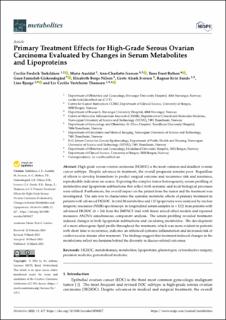| dc.contributor.author | Torkildsen, Cecilie Fredvik | |
| dc.contributor.author | Austdal, Marie | |
| dc.contributor.author | Iversen, Ann-Charlotte | |
| dc.contributor.author | Bathen, Tone Frost | |
| dc.contributor.author | Giskeødegård, Guro F. | |
| dc.contributor.author | Nilsen, Elisabeth Berge | |
| dc.contributor.author | Iversen, Grete Alræk | |
| dc.contributor.author | Sande, Ragnar | |
| dc.contributor.author | Bjørge, Line | |
| dc.contributor.author | Thomsen, Liv Cecilie Vestrheim | |
| dc.date.accessioned | 2023-08-15T09:18:10Z | |
| dc.date.available | 2023-08-15T09:18:10Z | |
| dc.date.created | 2023-04-20T18:08:03Z | |
| dc.date.issued | 2023 | |
| dc.identifier.issn | 2218-1989 | |
| dc.identifier.uri | https://hdl.handle.net/11250/3084060 | |
| dc.description.abstract | High-grade serous ovarian carcinoma (HGSOC) is the most common and deadliest ovarian cancer subtype. Despite advances in treatment, the overall prognosis remains poor. Regardless of efforts to develop biomarkers to predict surgical outcome and recurrence risk and resistance, reproducible indicators are scarce. Exploring the complex tumor heterogeneity, serum profiling of metabolites and lipoprotein subfractions that reflect both systemic and local biological processes were utilized. Furthermore, the overall impact on the patient from the tumor and the treatment was investigated. The aim was to characterize the systemic metabolic effects of primary treatment in patients with advanced HGSOC. In total 28 metabolites and 112 lipoproteins were analyzed by nuclear magnetic resonance (NMR) spectroscopy in longitudinal serum samples (n = 112) from patients with advanced HGSOC (n = 24) from the IMPACT trial with linear mixed effect models and repeated measures ANOVA simultaneous component analysis. The serum profiling revealed treatment-induced changes in both lipoprotein subfractions and circulating metabolites. The development of a more atherogenic lipid profile throughout the treatment, which was more evident in patients with short time to recurrence, indicates an enhanced systemic inflammation and increased risk of cardiovascular disease after treatment. The findings suggest that treatment-induced changes in the metabolome reflect mechanisms behind the diversity in disease-related outcomes. | en_US |
| dc.language.iso | eng | en_US |
| dc.publisher | MDPI | en_US |
| dc.rights | Navngivelse 4.0 Internasjonal | * |
| dc.rights.uri | http://creativecommons.org/licenses/by/4.0/deed.no | * |
| dc.title | Primary Treatment Effects for High-Grade Serous Ovarian Carcinoma Evaluated by Changes in Serum Metabolites and Lipoproteins | en_US |
| dc.type | Journal article | en_US |
| dc.type | Peer reviewed | en_US |
| dc.description.version | publishedVersion | en_US |
| dc.rights.holder | Copyright 2023 The Author(s) | en_US |
| dc.source.articlenumber | 417 | en_US |
| cristin.ispublished | true | |
| cristin.fulltext | original | |
| cristin.qualitycode | 1 | |
| dc.identifier.doi | 10.3390/metabo13030417 | |
| dc.identifier.cristin | 2142270 | |
| dc.source.journal | Metabolites | en_US |
| dc.identifier.citation | Metabolites. 2023, 13 (3), 417. | en_US |
| dc.source.volume | 13 | en_US |
| dc.source.issue | 3 | en_US |

